“The best playmaker in the world”.
No, we’re not talking about Johan Cruyff, Michel Platini or Diego Maradona.
According to Jürgen Klopp, it is, in fact, counterpressing.
Thus, in this tactical analysis piece, the best playmaker of the current European champions, Spain, will be scrutinised.
The Difficulties
The problem when analysing counter-pressing is that the basic situations are usually entirely different, and the execution is generally spontaneous.
While a team’s build-up play is constantly repeated from the same starting situation, counter-pressing can rarely be repeated one-to-one.
On the contrary, ball losses are usually not part of the plan, are subject to rapid decision-making by the players, and are, therefore, difficult to predict.
The Spanish are deploying a particularly effective counter-press.
This can be analysed based on various criteria and a large number of scenes.
The clear and well-practised sequences in the Spanish game ensure a certain predictability.
Priorities When Losing The Ball
It seems evident that the counter-pressing team’s priorities should be differentiated depending on the situation when the ball is lost.
So, when possession is lost and defence is lacking, the focus is not on winning the ball back immediately but on covering the centre close to the goal.
This is probably a logical risk/benefit assessment.
Typically, ball losses in offence occur more frequently in the opponent’s third, which provides defensive covering.
In contrast, ball losses in defence occur more regularly in your own third, and you rarely go into counter-pressing.
Therefore, it is exciting to examine moments of counter-pressing when the offence loses possession, typically in the opponent’s third.
Due to the particular proximity to the opponent’s goal, opposing counterattacks can be countered directly, and offensive transition moments can be created after winning the ball.
As the Spanish game is still primarily based on longer phases of possession and pressure in the opponent’s third, several scenes can be analysed.
Accordingly, this analysis focuses on those moments of counter-pressing in the opponent’s third when the ball is lost in the offence.
Staggering In Possession
The Spaniards operate from a nominal 4-3-3 on the ball in the opposing third, with number six Rodri, left number eight Fabián Ruiz, and right number ten Pedri/Dani Olmo.
In addition, the wingers Nico Williams and Lamine Yamal are usually very wide.
At the same time, the full-backs Marc Cucurella and Dani Carvajal play more centrally in their respective half-spaces, especially away from the ball.
It can often be observed that a maximum of one player is positioned at full width to create central superiority when unnecessary.
This is one of the most critical aspects of why Spain’s counter-press is so effective.
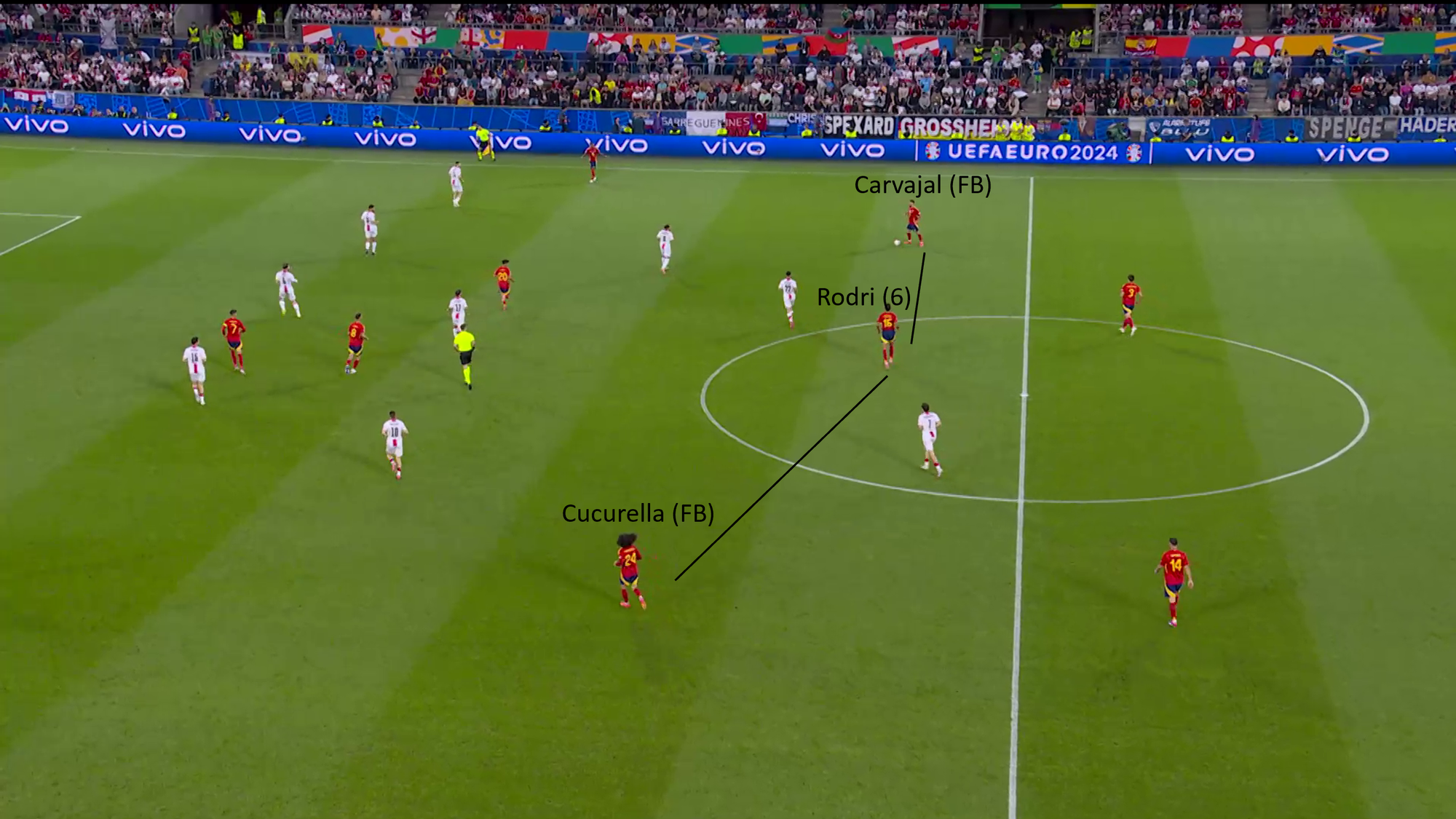
On the ball side, we’ll find the tucked-in full-back, number ten Pedri and/or striker Álvaro Morata, along with the anchor of Rodri or Fabián Ruiz.
This ensures an overload near the ball and constant pressure when the ball is lost.
When one side is overloaded, the passing routes are correspondingly short, and the players’ running routes to the ball are also shorter.
The result is less time for the opponent to make offensive switches.
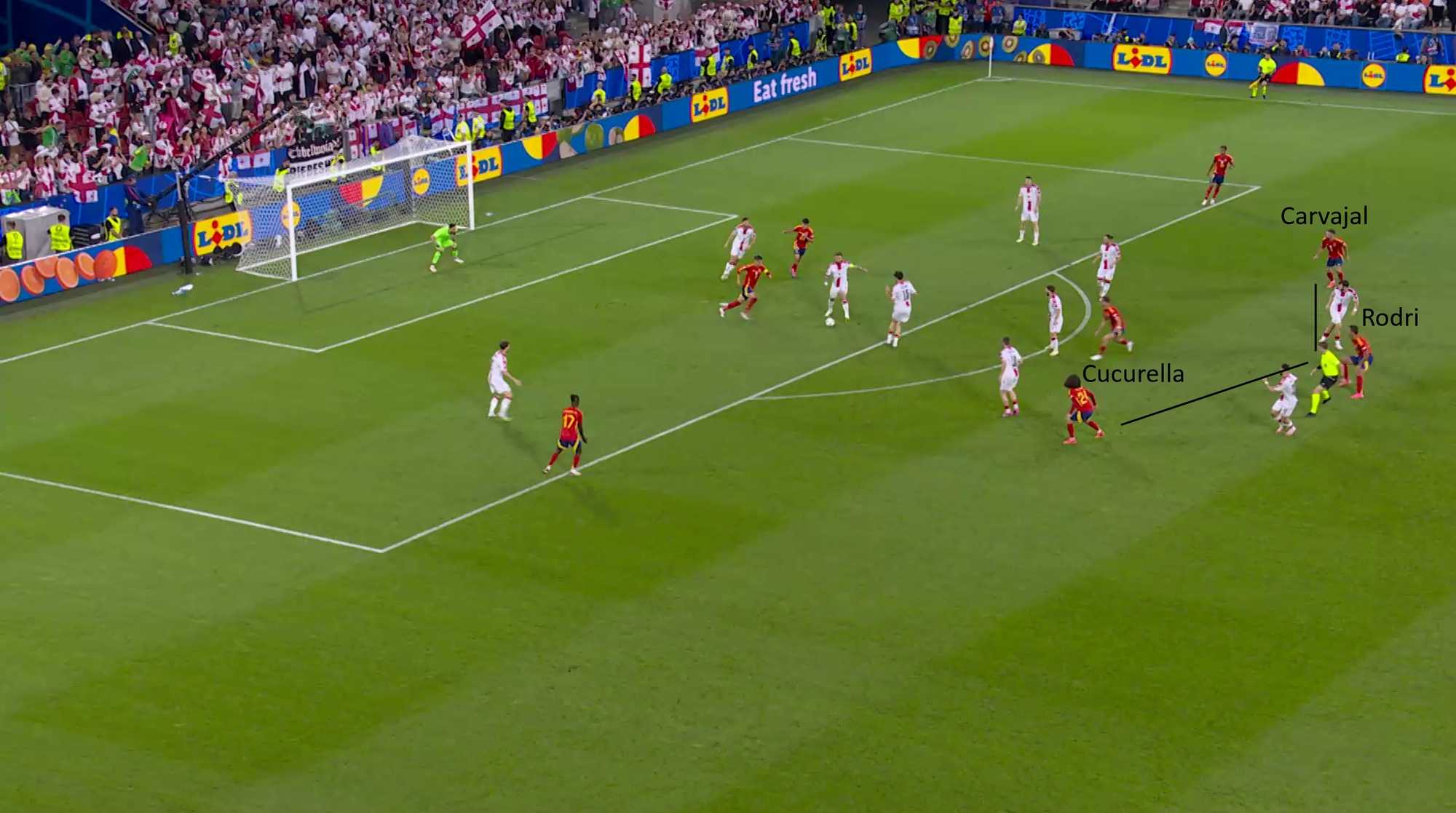
To maintain flexibility in possession, the players frequently rotate out of their actual positions.
Nevertheless, a special zonal division is observed.
If, for example, Cucurella plays deep on the left wing on the ball side, Williams will occupy the attacking half-space, and Fabián will enter the defensive half-space.
Rodri occupies the centre, and the full-back, away from the ball, moves towards the centre.
If, on the right, Carvajal goes deep on the wing on the ball side, Yamal will occupy the attacking half-space.
Rodri shifts to the half-space near the ball, and Fabián occupies the centre, with Cucurella tucking in.
Of course, this is just one of many examples of how such a rotation can look, but it is a move frequently utilised by the Spaniards.
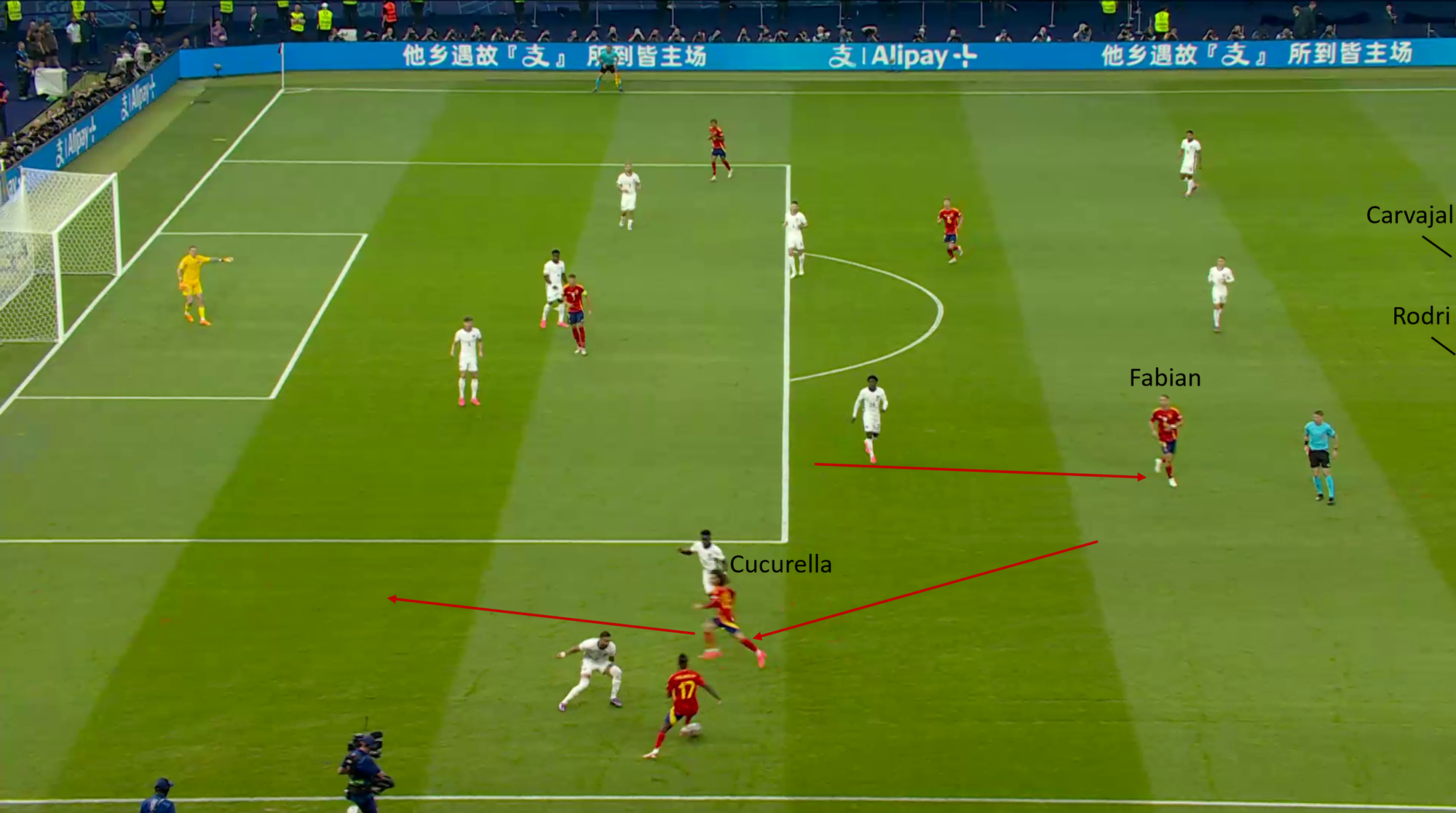
The defensive half-spaces and centre must be occupied at all times; in addition to the central defenders, the Spanish full-backs and number six Rodri can usually be found in these areas.
However, as the Spanish game can be very volatile in possession, appropriate procedures are established to protect against the ball.
This zoning prevents a focus on the side away from the ball or on the front zones, making counter-pressing more effective.
Even if such zoning is very effective against the ball, the Spanish players naturally have several principles of play simultaneously when in possession.
After all, the primary goal of Spanish possession is not usually to prevent an opponent from scoring but to score a goal itself.
This means that specific patterns can be softened depending on the priority of the respective game situation, as six players flexibly create the remaining defence.
For example, Rodri could move from his defensive midfielder position to the second wave of the penalty box to finish.
This also happened during the one-on-one equaliser against Georgia when they were a goal down in the 39th minute.
Spanish Ball Possession: Ideal For Counterpressing Moments
Why does Manchester City under Pep Guardiola, FC Bayern under Jupp Heynckes, Ajax under Erik ten Hag or even the Spanish under Luis de la Fuente coaching style have such success counter-pressing?What all teams had/have in common is a focus on a lot of ball possession in the opponent’s third.
This benefits individual actions, not least the passing quality.
Logically, sharper passes make it more difficult for opponents to control the ball when it is won back.
Other factors also increase the probability of winning the ball back; the way the ball is lost can be a decisive factor.
Short passes have the advantage of directly restricting the opponent’s radius of action, as you have at least two directions covered if the ball is lost.
On the other hand, a longer, high ball is more straightforward to intercept due to the longer travelling time.
Because longer balls are less controllable than short passes, there is also a corresponding lack of control in the follow-up action.
Counterpressing is more random and also less predictable.
In addition, Spain under Luis de la Fuente’s style of play, hardly have any “open” ball losses in the build-up positions, but mainly on the other side of the opposing six.
Of course, this is also due to the individual quality of their build-up players, in this case, primarily Rodri.
This ensures that they do not have to switch directly into a defensive transition but can immediately go into counter-pressing.
Spain, therefore, already benefits from the way they play possession football when counter-pressing.
Anticipation Of The Counterpressing Situation
As counter-pressing situations often involve deciding as quickly as possible, it is essential to give yourself enough time to anticipate the problem.
This can be improved through implicit training, analysing certain game situations, and defining principles to ensure a time advantage.
True to the principle of “risk determines pressure”, Cucurella is usually already preparing for counter-pressing (dynamically and spatially) when Williams switches to high-risk bypass-dribbling towards the opponent’s goal.
Here, the probability of losing the ball is relatively high, and a counter-pressing situation could arise.
This “knowledge advantage” is often enough to get back on the ball faster than the opponent.
Triggers For Counterpressing
In order to anticipate counter-pressing situations even better, specific triggers for counter-pressing can be defined.
Anticipation and triggers are closely linked.
If you define certain game situations as triggers, you can also anticipate them better.
Although there are no deliberately misplaced passes in the Spanish game to create offensive transition moments through counter-pressing, accepting a loss of the ball in a very risky 1v1 or 1v2 dribble can be counted as one of these frequent triggers.
In particular, when Williams dribbles into the penalty area, it is not only clear that Cucurella is preparing for a moment of counter-pressing, but Rodri also pushes closer to the ball in the centre to have a more extensive cover shadow.
In such situations, Carvajal, who is far away from the ball, does the same as Rodri and pushes even further towards the side near the ball to create numerical superiority in the centre.
Another frequent trigger in the Spanish game are through balls into the half-space behind or onto the last line.
This happened, for example, in minute 53:50 against Georgia.
Rodri plays the ball to the deep-running Williams.
It is then intercepted by a Georgian defender in the last line.
The Spaniards’ advantage is the limited number of opportunities for the ball-winning Georgian player.
The result is a quick ball recovery; this scene will be analysed in more detail below.
Processes In Counterpressing: In-Game Examples
As mentioned at the beginning of this piece, counter-pressing situations are pretty variable and intuitive, depending on the game situation.
The patterns of play also differ depending on the circumstances.
Many different factors play a role here, such as the zone where the ball is lost, the team’s own ball-side spatial coverage, the opponent’s coverage variants or even the result of the game and the associated willingness of both teams to take risks.
Nevertheless, a framework can be outlined for how Spanish counterpressing works.
When the ball is lost in the deep half-space, as in the 54th minute against Georgia, the deep-lying winger, in this case, Williams, usually applies pressure immediately behind the ball-possessor, and the goalkeeper is taken out of the game as an outlet to keep the pressure high.
Williams tries to win the ball directly as he presses aggressively while channelling into a counter-pressing situation.
This usually arises in the centre or half-space, where the teammates can move on the ball side through a space-oriented covering behaviour and create covering shadows and superiority in these zones.
Rodri covers the centre, Cucurella has half the space on the ball side, and Carvajal has half the space away from the ball.
The striker, Morata, positions himself so that he can exert pressure on the centre-backs.
Fabián and Pedri position themselves in the half-left and half-right offensive half-spaces.
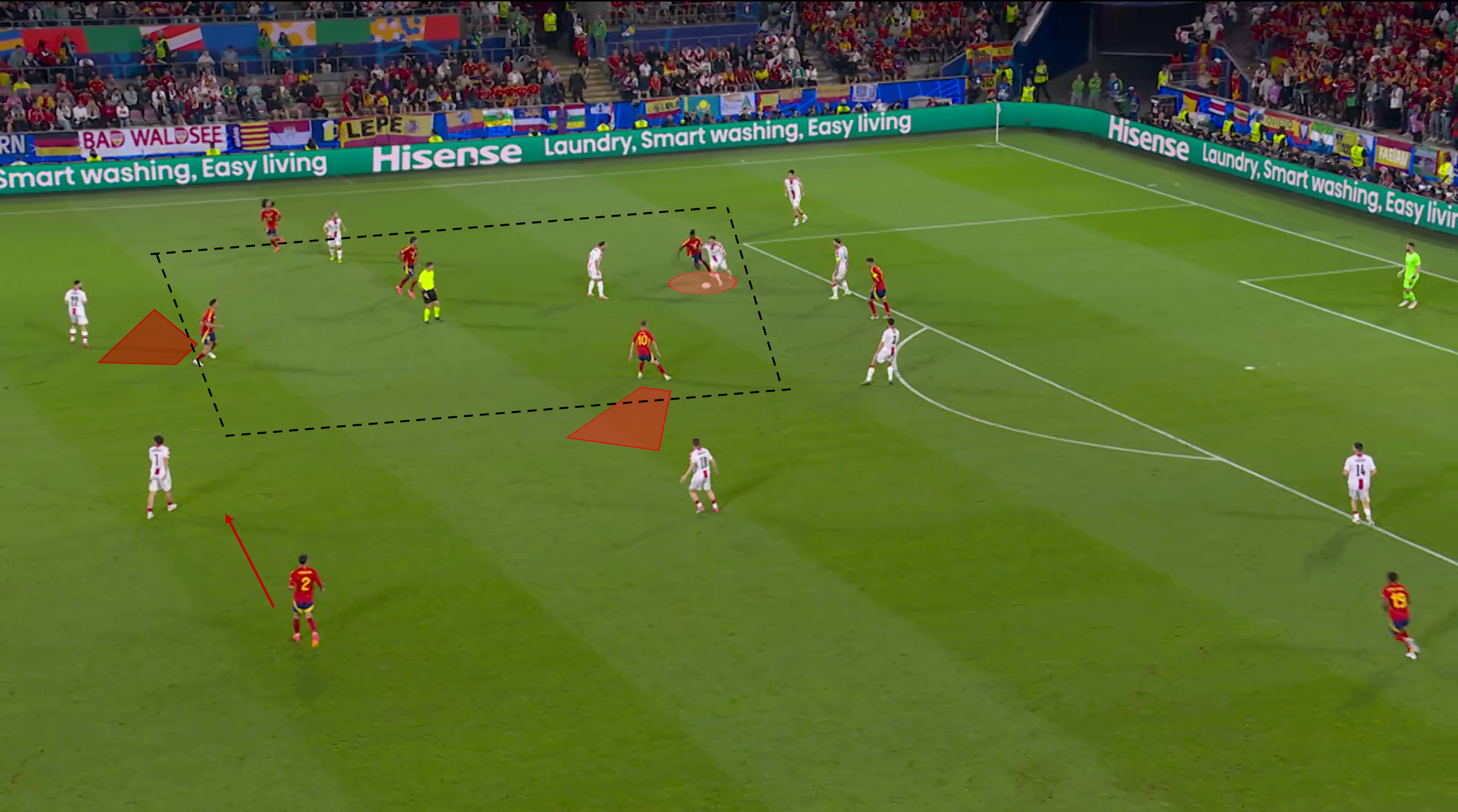
The inverted full-back presses very often in the slightly higher half-space closer to their own half.
This can also be seen in minute 45+1 against Germany.
Here, for once, the inverted David Raum wins the ball and can find Sané on the other side with his first touch.
Nevertheless, Spain finds a way into the counter-press.
Cucurella puts Sané under direct pressure in order to win the ball.
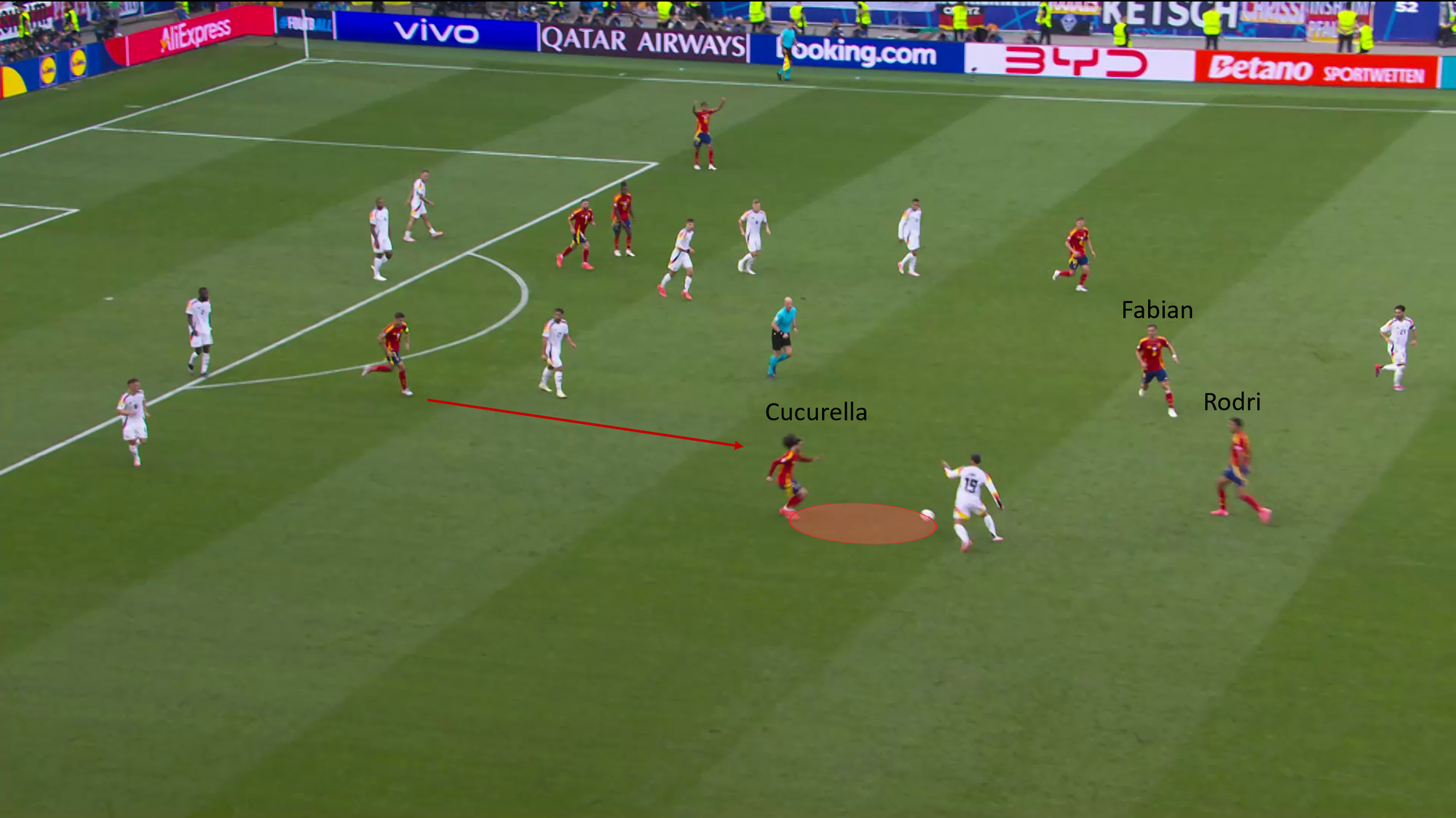
Rodri and Fabián cover the centre with a space-oriented approach, while Morata once again prevents Sané from playing out of the pressure in the direction of his own goal.
Spain are able to win the ball as a result.
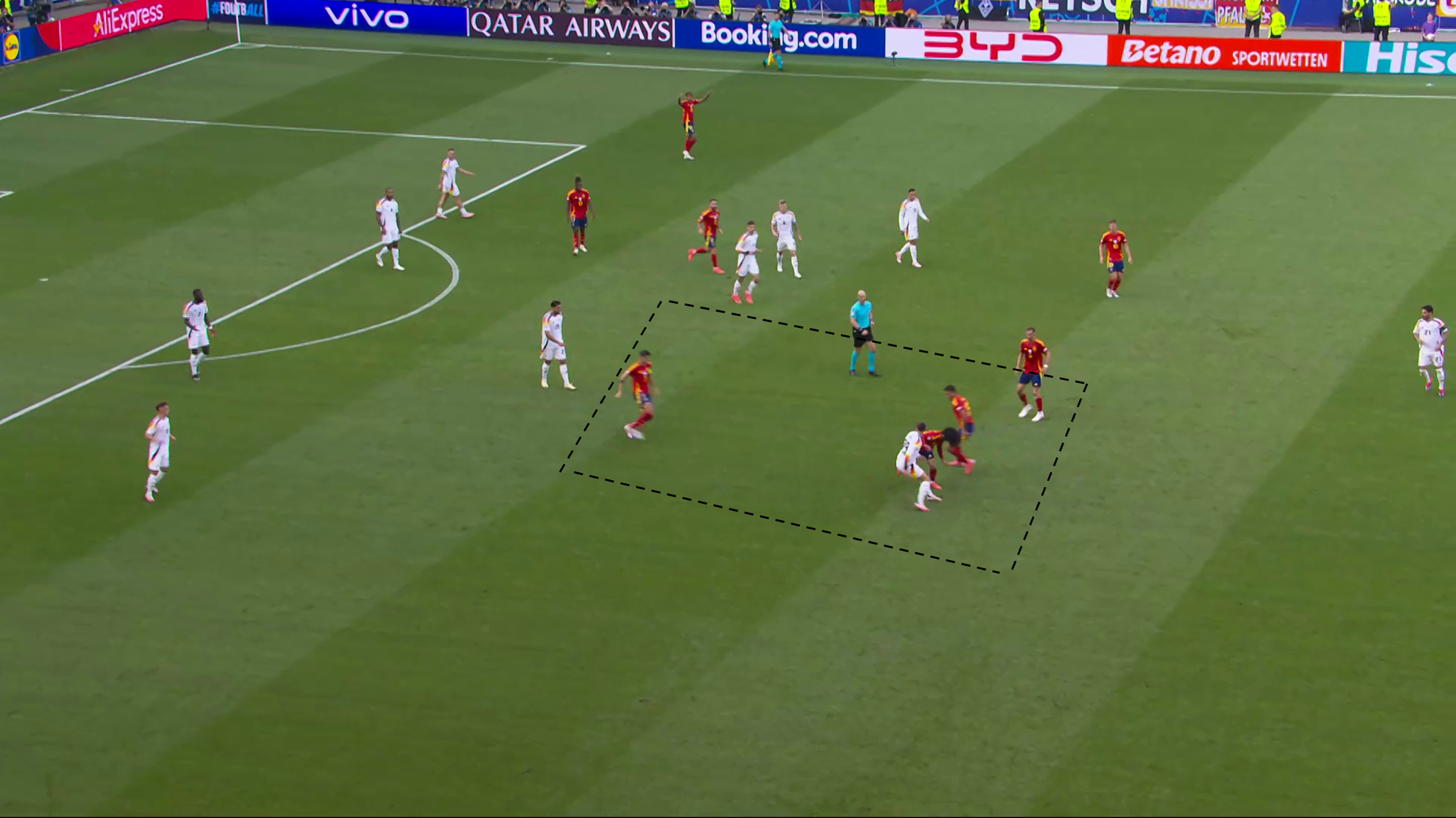
If you continue watching this scene, you will see Carvajal and Cucurella in another counter-pressing action in the centre.
This is an excellent example of the intensity of the pressing players.
However, this also highlights a disadvantage of this highly aggressive pressing.
Although the pressure on the player with the ball is maximised, the opponent is often fouled when trying to win the ball.
It is impossible to keep up with the opponent’s quick direction changes without containing and slowing down the opponent.
Due to the frequent fouling, offensive transitions are consequently often prevented.
When the ball is lost in the deep centre close to the opponent’s goal, Morata usually presses first in counter-pressing.
In the 38th minute against Italy, Williams loses the ball in the centre of the opposition penalty area.
Morata puts pressure on, tries to win the ball directly and channels away from the Italian goal.
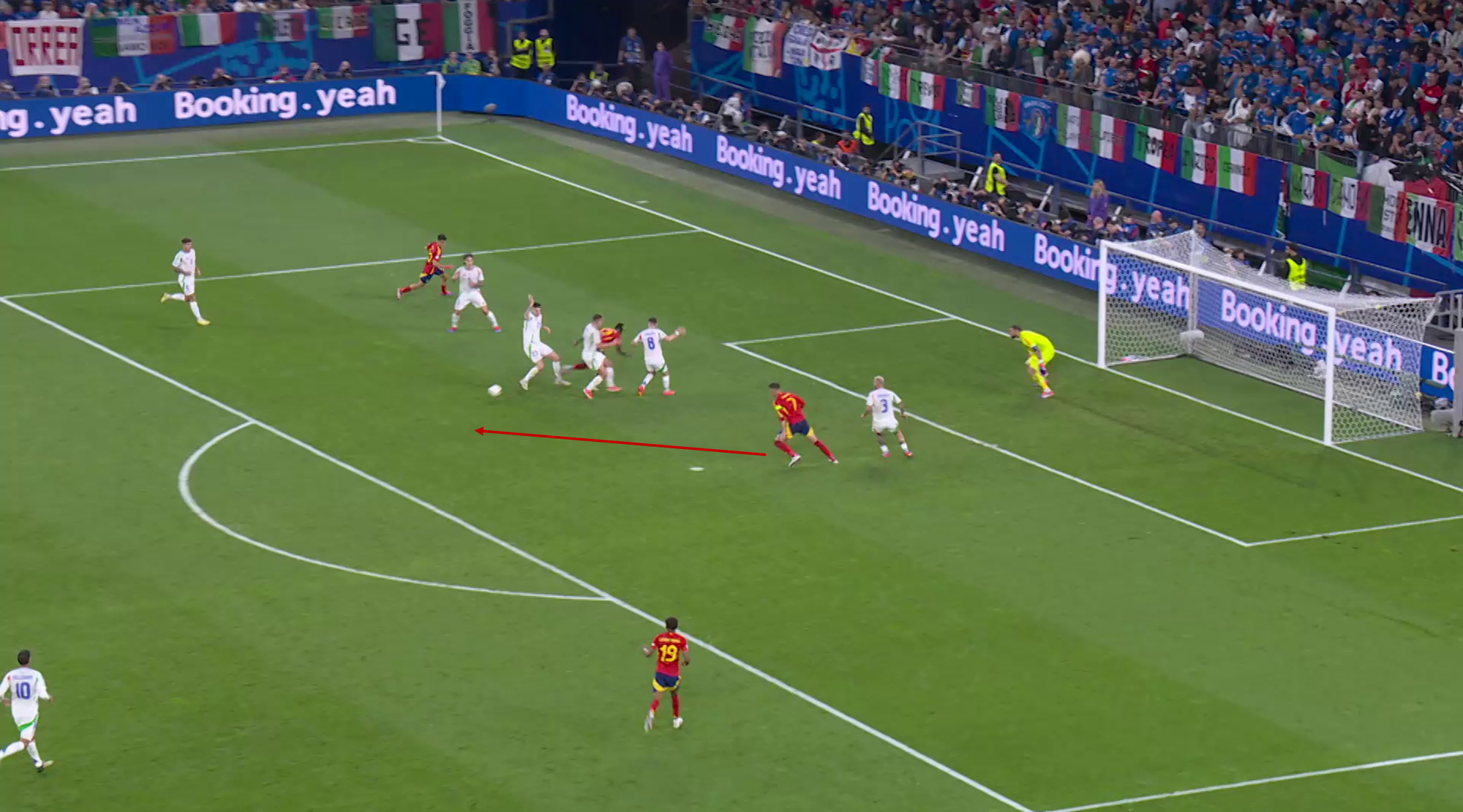
Despite Morata disturbing the opponent, the first pass reaches its target indirectly.
However, the inverted Carvajal, Cucurella, Rodri, and Fabián immediately stopped the Italian counterattack.
Here, as a full-back in the centre, Cucurella attacks the Italian ball possessor extremely aggressively without slowing him down.
Meanwhile, his teammates limit the ball possessor’s options—in this case, Chiesa—while simultaneously containing him.
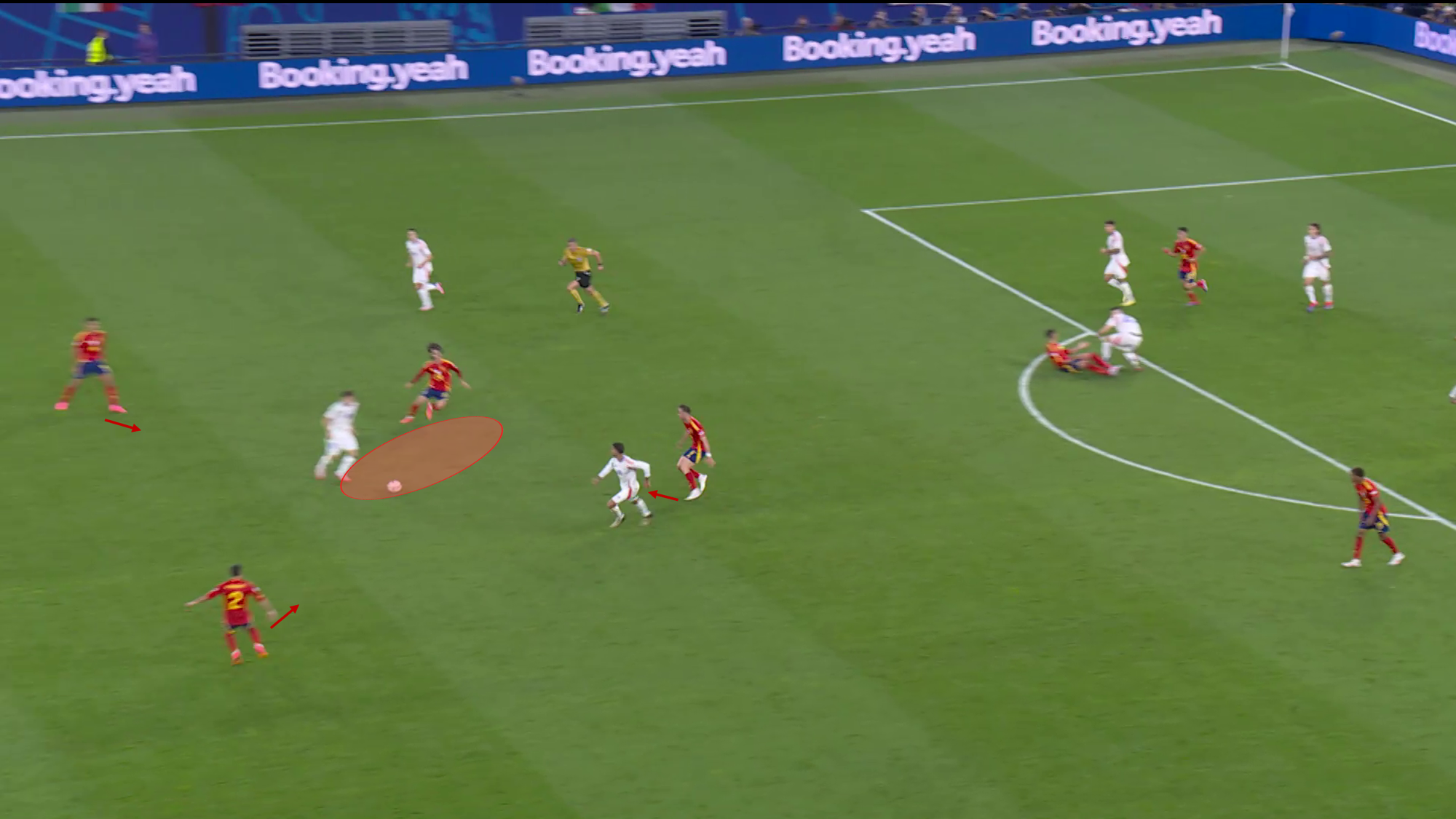
General Processes In Counterpressing
The tasks of the individual players can differ depending on the particular game situation.
Different players can occupy the zones depending on your possession structure, as described in the section “Staggering In Possession” above.
This naturally also has an effect on the counter-pressing structure.
Not all players consciously participate in the direct recovery of the ball.
In particular, the wingers away from the ball and/or 10 are often offensive transition players after recovering the ball.
The defensively covering centre-backs also do not directly participate in the ball recovery.
As a general rule, the player closest to the ball attacks.
Therefore, the opponent’s deep half-space usually includes the wingers, while in the slightly higher half-space, the full-backs are usually present, with Morata in the deep centre.
In addition, only a single player attacks the player with the ball directly and aggressively without the usual slowing down, while the other players merely try to contain it.
Another feature is the cutting off of space behind the ball possessor, usually by striker Morata, which increases the pressure to a maximum, but at the expense of protecting their own goal.
It is worth noting that the Spanish game is designed for central superiority and, accordingly, the vast majority of counter-pressing situations are directed towards the centre.
On the one hand, this harbours a considerable counterattacking risk, as opponents can potentially be played deep on both sides.
On the other hand, it also offers an excellent chance of winning the ball, which can create more promising offensive transition moments than if the ball is won on the wing.
Under Luis de la Fuente’s tactics, the most noticeable players in Spain’s counter-pressing are the aggressive full-backs.
They provide the necessary overload in the centre and win the vast majority of balls when counter-pressing — a unique selling point at this European Championship.
Dropping Out Of Counterpressing
In most cases, counter-pressing ends with Spain winning the ball or committing a foul.
If the opponent breaks free from the pressure in the direction of the goalkeeper, Spain often switches to an attacking press.
They only drop back if they can no longer exert pressure due to their own unfavourable positioning.
Weaknesses Of Counterpressing
Spain’s counter-pressing resulted in significant problems against Germany at the European Championship 2024.
The man-to-man defending made creating numerical superiority in the centre in transition moments almost impossible.
In addition, Spain rarely had prolonged periods of possession in the opposing third, as the Germans mostly attacked in a man-orientated high press.
Against France at the European Championship 2024, it was noticeable that the Spaniards did not play such an aggressive counter-pressing game with their full-backs.
This was due to France’s quick counterattackers in the form of Kylian Mbappé and Ousmane Dembélé.
Using inverted full-backs, they aimed to prevent the French from gaining large spaces on the wings during transitions.
This only worked at the expense of a slightly less effective counter-press.
Similar conditions could be observed in the final of the European Championship 2024 against England, as both sides focused on taking as few risks as possible to avoid falling behind.
Conclusion
It can be said that La Furia Roja’s counter-pressing is a real weapon that generally suits the personnel they have available in midfield, out wide, and at the back.
This Spain men’s football analysis highlights why Luis de la Fuente counter-pressing tactics have helped them secure victories and will continue to do so in the future.

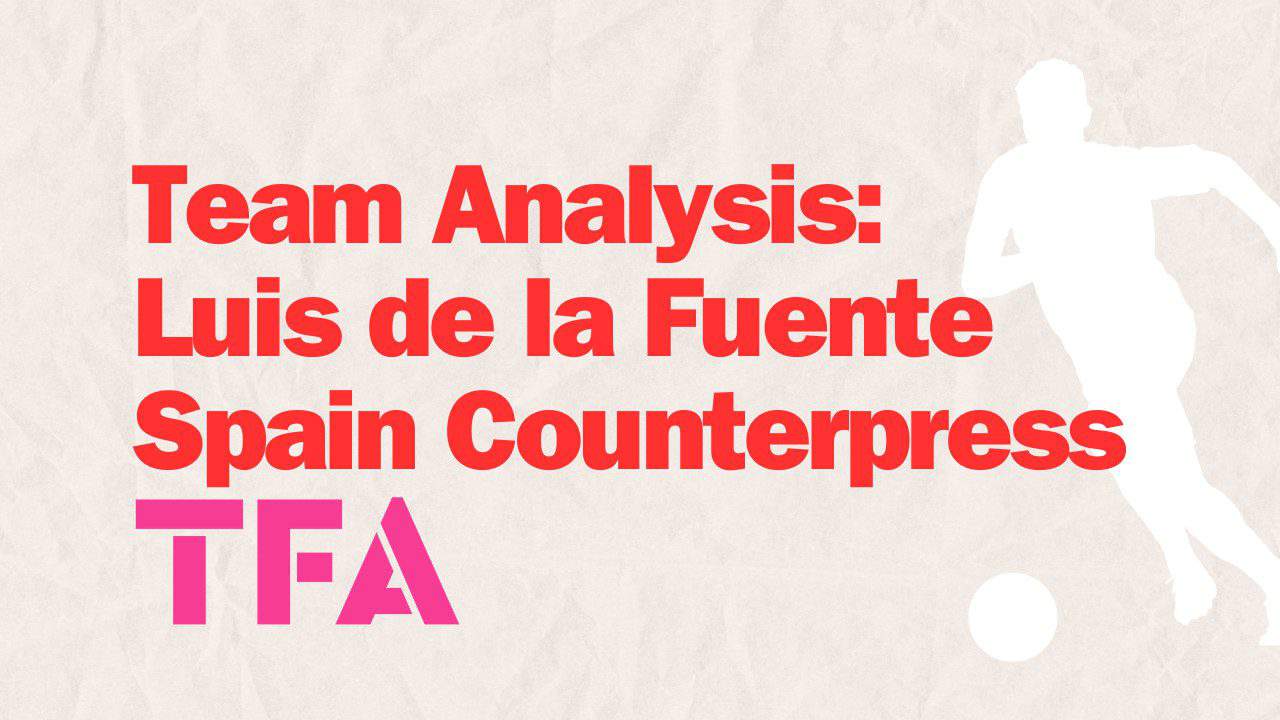




Comments